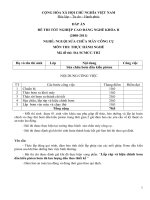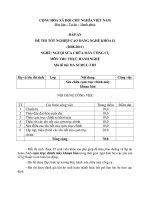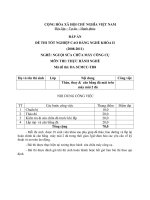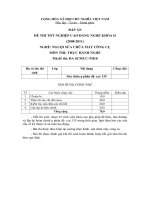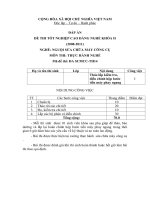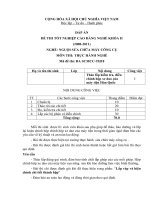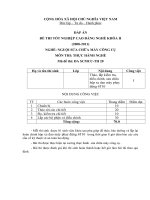De thi Thuong mai doc chuyen nganh
Bạn đang xem bản rút gọn của tài liệu. Xem và tải ngay bản đầy đủ của tài liệu tại đây (173.54 KB, 2 trang )
B
à
i
t
h
i
k
ế
t
t
h
ú
c
h
ọ
c
p
h
ầ
n
B
à
i
t
h
i
m
ô
n
:
T
i
ế
n
g
A
n
h
T
M
Đ
ọ
c
1
H
ọ
v
à
t
ê
n
:
.
.
.
.
.
.
.
.
.
.
.
.
.
.
.
.
.
.
.
.
.
.
.
.
.
.
.
.
.
.
.
.
.
.
.
.
.
.
.
.
.
.
.
.
.
.
.
.
.
.
.
.
.
.
.
.
.
.
.
.
.
.
.
.
.
.
.
.
.
.
.
.
.
N
g
à
y
s
i
n
h
:
.
.
.
.
.
.
.
.
.
.
.
.
.
.
.
.
.
.
.
.
.
.
.
.
.
.
.
.
.
.
.
.
.
.
.
.
.
.
.
.
.
.
.
.
.
.
.
.
.
.
.
.
.
.
.
.
.
.
.
.
.
.
.
.
.
.
.
.
.
.
.
.
.
.
.
.
.
.
.
.
.
.
.
.
.
.
.
.
Q
u
ê
q
u
á
n
:
.
.
.
.
.
.
.
.
.
.
.
.
.
.
.
.
.
.
.
.
.
.
.
.
.
.
.
.
.
.
.
.
.
.
.
.
.
.
.
.
.
.
.
.
.
.
.
.
.
.
.
.
.
.
.
.
.
.
.
.
.
.
.
.
.
.
.
.
.
.
.
.
.
L
ớ
p
:
.
.
.
.
.
.
.
.
.
.
.
.
.
.
.
.
.
.
.
.
.
.
.
.
.
.
.
.
.
.
.
.
.
.
.
.
.
.
.
.
.
.
.
.
.
.
.
.
.
.
.
.
.
.
.
.
.
.
.
.
.
.
.
.
.
.
.
.
.
.
.
.
.
.
.
.
.
.
.
.
.
.
.
.
(Do hội đồng
chấm thi ghi)
V. (1 im)
The Chinese Government has been active in making free trade area (FTA) proposals and
top leaders even suggested the establishment of an East Asia FTA covering ASEAN,
China, Japan, and South Korea.
Statistics show that about 100,000 Chinese tourists visited the Philippines last year, up to
200 percent on the previous year, and the multiple choices of transport modes to
Vietnam were also convenient for Chinese tourists.
As more and more goods and services are produced, the economy grows and the best
way to measure this growth is to put a monetary value on everything bought and
sold.
The increase in prices usually leads workers to ask for increasingly higher salaries to
keep up with inflation.
Cụng ty m l cụng ty iu khin cỏc cụng ty khỏc nh hn.
Nu nh s sn xut ca th gii v cỏc mụ hỡnh thng mi tuõn theo nguyờn lý li
th cnh tranh, sn lng v tiờu dựng ca th gii s t mc cao nht.
Thng mi v u t ang lu thụng vi s lng ln gia Chõu v Trung ụng
(the Middle East).
Cnh tranh cú th thỳc y cỏc doanh nghip (enterprises) ci thin cht lng v
tng cng a dng hoỏ sn phm.
TRƯờNG CĐ SƠN LA
Tổ CHíNH TRị NGOạI NGữ
Bài thi kết thúc học phần
Môn: Tiếng AnH TM c 1
đề 1
Thời gian làm bài: 120 phút (Không kể thời gian phát đề)
Điểm kết luận của bài thicán bộ chấm thi thứ nhấtcán bộ chấm thi thứ haiGhi bằng sGhi
bằng chữ
!
(Thí sinh
ghi cả phần
chữ và số)
P
h
ò
n
g
t
h
i
s
ố
:
H
ọ
t
ê
n
v
à
c
h
ữ
k
ý
c
ủ
a
c
á
n
b
ộ
H
ọ
t
ê
n
v
à
c
h
ữ
k
ý
c
ủ
a
c
á
n
b
ộ
c
o
i
t
h
i
t
h
ứ
n
h
ấ
t
c
o
i
t
h
i
t
h
ứ
h
a
i
C
h
ú
ý
:
Y
ê
u
c
ầ
u
c
á
n
b
ộ
c
o
i
t
h
i
g
h
i
r
õ
c
ả
h
ọ
v
à
t
ê
n
T
h
í
s
i
n
h
c
ầ
n
g
h
i
đ
ầ
y
đ
ủ
c
á
c
m
ụ
c
ở
p
h
ầ
n
t
r
ê
n
(Do hội đồng
chấm thi ghi)
Điểm
kết quả
Câu I:
Câu II:
Câu III:
Câu IV:
Câu V:
Câu VI :
Tng im
.
"#$% &'()&*+,-./0/1/ 2
23
40++5676&$ &6& !&$
6+6 0&! â 6& 6+67
In order to comply with the customers specifications, the factory had to make
several in the design.
A. corrections B. mistakes C. adjustments D.
repairing
The difference between the cost of making something and the profit of selling it is the
A. tax zone B. border cost C. margin D. edge
A promise that a product will perform as advertised is a
A. special offer B. guarantee C. promotion D.
voucher
The year is a period of twelve months arbitrarily chosen for tax purposes.
A. economic B. fiscal C. taxing D. monetary
Before these articles leave the factory to be forwarded to the retailer, each one is
thoroughly
A. seen B. looked at C. appraised D. inspected
Good procedures are very important if you want to run a business
profitably and successfully.
A. accountants B. accounting C. accounts D. accounted
A 's market is a market where there are more buyers than suppliers.
A. buyer B. shopper C. seller D. money
I regret to inform you that as your guarantee last week, we can't help you.
A. died B. extinguished C. expired D. deceased
GAAP are a combination of rules set by policy boards and the
commonly accepted ways of recording and reporting financial information.
A. authoritative B. guideline C. optional D. powerful
It may seem a long way into the future but in the end you will get
some from your investment.
A. produce B. benefit C. products D. price
T
h
ớ
s
i
n
h
g
p
g
i
y
t
h
e
o
n
g
k
n
y
ThÝ sinh
kh«ng ®îc viÕt vµo phÇn cã g¹ch chÐo
" 228!9:%;< =&
%3
economic growthrecession protectionismquality
controlmicroeconomicsmacroeconomicssupplyinternational demandaccounting
standardseconomic crisissalary negotiationsexchange rategoods marketsdistribution
channelterms of paymentconsumer goodsThe Japanese economy, after years of trade and
budget surpluses, is in deep and the growth rate has slowed
down considerably.
is primarily focused on the actions of individual agents,
such as firms and consumers, and how their behavior determines prices and quantities in
specific markets.
South Korean has been one of the champions of , with
annual economic growth of almost 6% in gross domestic product (GDP) per capita.
Protection would be cut and the economy would be opened to foreign competition, first
in and later in capital markets.
The theory of commercial policy or examines the reasons
for and the effects of trade restrictions.
You should have read the as soon as you received the
invoice for the goods.
Generally Accepted Accounting Principles are a set of
approved by the professional accounting industry.
I believe that is all about checking that products match the
specifications and standards.
By 1973, increasing made oil a scarce and
valuable commodity.
The between car workers unions and their employers have
broken down.
>?2% 72?+@()&*+,-. AB
C!(DE
COMPANY BUDGETS
Most senior executives know that the competitive battles ahead will involve not only
ensuring that their company gets better at what it does, but is also different from others. To achieve
this they need talented managers who can produce more imaginative strategies for growth and
improvement, make faster decisions, be more flexible, be better prepared to anticipate threats and
opportunities, and who can consistently improve quality and customer satisfaction.
But executives also know that none of these expectations are attainable without changing
the way the business is run. While most companies have tried to reduce management layers and
focus on the customer, few have been successful. One of the reasons is the inability to change the
management philosophy from one of top-down control to bottom-up empowerment. It is because
budgets are commonly used by organisations to exercise control that they are at the centre of this
issue.
Budgets are, in effect, barriers to change and fail to do well what most managers think they
do well – that is, provide order and control. They are barriers for many reasons. Firstly, they
reinforce the command-and-control management model and thus undermine attempts at
organisational change, such as delegation and empowerment. In addition, they tend to set a ceiling
on growth potential and a floor for cost reductions, thus preventing real improvement breakthroughs.
Additionally, they act as barriers to exploiting cooperation across the business units.
If asked why we use budgets, most managers would probably answer, ‘to set targets and
control business operations’. But budgets evolved in the 1920s to help growing businesses manage
their capital resources and plan their cash requirements. It was not until the 1960s that budgets
were used to set targets, control operations and evaluate managerial performance. While planning
remains an important part of the management process, it is widely believed that setting targets and
controlling and evaluating performance using budgets is fundamentally of weaknesses because it
directs managerial behaviour towards achieving predetermined financial targets rather than
exploiting the energy of people at all levels towards continuously improving competitive strategies
and customer-oriented processes.
So, if existing budgeting systems have such crucial weaknesses, why do we still rely on
them? In fact, accountants have tried to improve them. Zero-based budgeting and activity-based
budgeting represent brave efforts to update the process, but they tend to be complex project-driven
approaches that fail to develop into standard management practices. Basically, though, budgeting
has not changed because it is a part of accepted tradition.
What does all this mean for the role of management accountants? Many accountants now
accept that setting fixed financial targets and measuring performance against them does not work
effectively when the competitive environment is subject to continuous change. Plans and strategies
need to spread continuously as new knowledge emerges. Above all, management accountancy
should be concerned with the future and ensuring that the right questions are asked and the right
decisions are taken that add maximum long-term value.
1. To deal with the competition they are likely to meet in the future, companies should
look for managers who will
A bring considerable experience to the job.
B respond immediately to financial difficulties.
C take a creative approach to developing the business.
2. According to the second paragraph, why have companies failed in their response to key
competitive issues?
A Authority for decision-making is too restricted.
B There are too many layers of management.
C Budgets are not adequately monitored.
3. One problem resulting from the way budgets are usually set is that
A they allow staff to avoid taking responsibility for their decisions.
B they tend to produce too many targets for the workforce to meet.
C they limit innovative behaviour because they focus on past experience.
4. According to the writer, changes in the use of budgets since the 1960s have prevented
managers from
A giving enough time to planning.
B concentrating on motivating the workforce.
C working out realistic targets.
5. According to the writer, why have new budgeting systems not been widely adopted?
A Traditional systems are relatively easy to operate.
B New systems are slow and expensive.
C Traditional systems are part of accepted practice.
6. According to the final paragraph, many management accountants now believe that
A companies should be prepared to modify their strategies.
B budgeting should not influence management decisions.
C too many company decisions are taken with a short-term view.
IV. >F!G-HI# 22
DEPEND SUNRISE ELECTRONICS Co. Ltd. is becoming more and
more on foreign orders.
ADVERTISE is such a competitive profession.
POPULAR Recently health foods have increased in
RESPONSIBLE His boss fired him because he had
behaved
PROMOTE The of our new product range starts next week.
